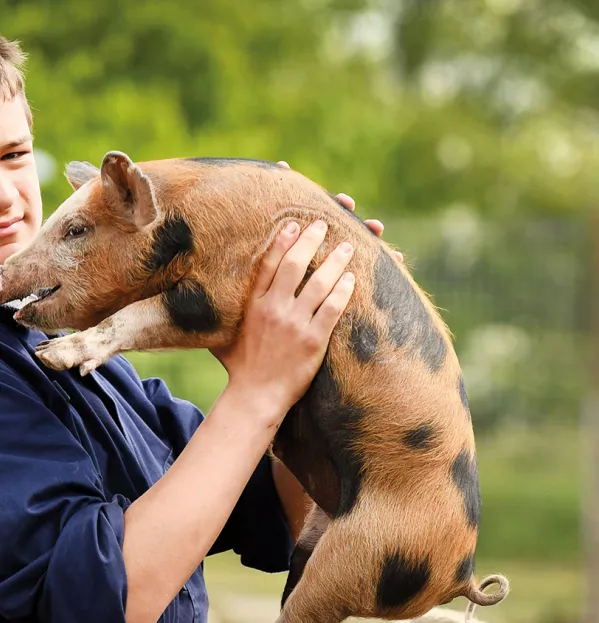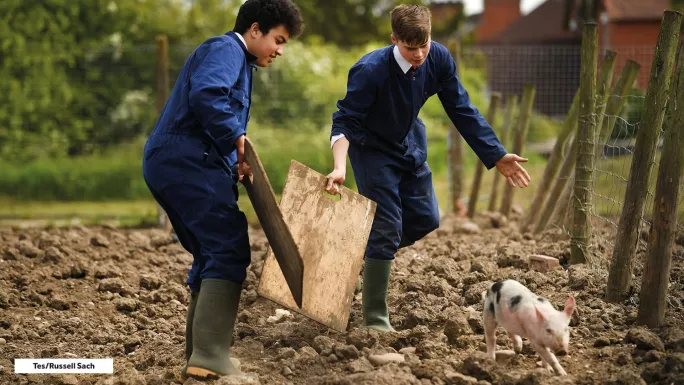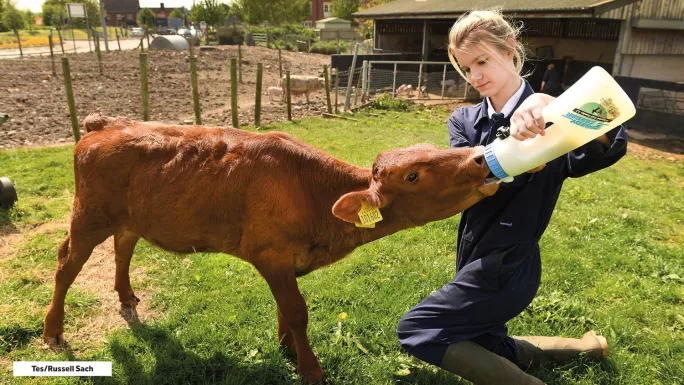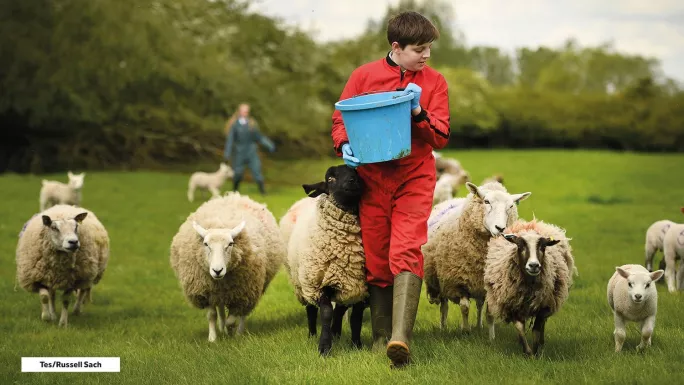The class menagerie

Six-year-old Leonard* is weeping. Wailing. Sobbing. The boy, who has profound special educational needs and limited language, has just been told that he can no longer go on the outing from John Stainer Community Primary School owing to a doctor’s appointment. He is distraught.
“We can make something nice happen for you in school today,” offers headteacher Sue Harte, trying to cheer him up.
The tears stop and he looks up.
“Charlie?” he asks hopefully, with the beginnings of a smile.
Charlie Brown is John Stainer’s miniature labradoodle. If, as a school pet, he sounds a mite more adventurous than a class gerbil, he is far from the only - nor the most unusual - one. Tes reported in March about the increasing number of school dogs and in a 2015 survey by pet retailer Pets at Home, 22 per cent of parents reported that their children’s school had pets. And - while this survey found that rabbits, hamsters and guinea pigs made up 60 per cent of them - lizards, Indian runner ducks, pygmy goats and alpacas have also taken up residence on UK school premises.
Keeping animals is expensive, labour-intensive and time-consuming, so the benefits must be significant, right? Schools who have them think so, citing students’ strengthened social skills, better behaviour, improved attendance and more robust relationships .
And many of us will fondly remember from our own primary years a class goldfish or hamster, perhaps a school guinea pig. As behaviour support consultant John Murray says: “Using animals in schools to enrich the learning experience has a long tradition and most schools at some point, particularly at primary level, will have used them.”
But does the evidence back up this long-established practice?

For some schools, one pet is not enough. Instead, they run whole farms: the School Farms Network says there are more than 110 of these in the UK. And many of these farms are not recent additions to the curriculum. Thomas Alleyne’s High School’s farm in Uttoxeter, Staffordshire, was set up during the Second World War, and started with just vegetable plots and poultry. Bedales School, meanwhile, has been running its comprehensive working farm since it moved to its current site in Steep, Hampshire, in 1900.
Thomas Alleyne’s High School (pictured) is now home to sheep, cows, pigs, chickens, ducks, guinea pigs, rabbits and a bearded dragon (a type of lizard), and is supported by the National Farmers’ Union. The farm is used to teach GCSE environmental and land-based science (which will be swapped for a Btec in animal care in the next academic year). Direct links to courses, like in this case, are the most straightforward and obvious of the roles of animals in schools.
“It has to be a teaching tool because that’s the only way we can get funding,” says Thomas Alleyne’s deputy head of science, Justine North, adding that aspiring vets also benefit. “Veterinary medicine is very competitive, so any extra help we can give them is going to be very beneficial.”
But farms - and animals in general - can be used for broader curriculum needs. North says the farm also acts as a teaching tool for traditional science and even arts subjects.
“We do drop-in sessions with other departments,” she explains. This might be to teach selective breeding and ethics in science, for example. Or the history department might pop in to discuss the farm’s roots as a wartime Dig for Victory initiative.
And it’s not just formal, structured teaching for which animals can be of benefit, says Keith Budge, headmaster at Bedales. Its farm includes 35 pigs, 25 chickens, bees and 27 Jacob ewes.
As well as looking after the animals, Bedales’ students build beehives and duck houses, butcher animal carcasses, cure sheepskins, make sausages, churn butter and run a farm shop. All of these activities are opportunities for learning that go beyond the task itself, says Budge.
“I have walked in on a class where they were curing sheepskins and they were having the most amazing conversations about the ethics of rearing animals and the chemical process,” he explains. “It’s learning by doing.”
But it’s hard to see how the benefits of these farm settings apply to smaller-scale operations, be it a few goats, a dog or even just a goldfish. So what’s their role?
Looking after animals helps children to develop essential life and social skills and behaviours, explains Murray, founder and director of Jogo Behaviour Support and an advocate for the use of animals in schools. “Nurturing and caring for an animal can be a way of developing self-esteem, self-worth and empathy for others, while at the same time teaching basic social skills such as cooperation and responsibility,” he says.
Headteacher Mike Bennett has been surprised just how profound these benefits have been since his school, Ridgeway Academy in Worcestershire, acquired three sheep, two goats and a dog, primarily to create a “unique selling point”.
“I didn’t understand the impact that the animals would have until we had them,” he confesses. “The animals have helped children with their self-esteem and confidence...We have noted a positive impact the animals have on children when they are stressed or upset.”
Improvement in attendance has been one of the biggest benefits.
Welcome to goat club
“There are some children who come to school and I’m not sure that they would if we didn’t have the animals,” Bennett says. “There’s one in particular; if he wasn’t doing goat club, I’m pretty sure he wouldn’t be in school very much - but you can’t keep him out of there.”
He adds that internal research shows that problem behaviour decreases among students on Ridgeway Academy’s Shine programme, which makes widespread use of animals as part of support for students’ social and emotional wellbeing. He is convinced that “the animals do have an impact on behaviour”.
Darton College in Barnsley, South Yorkshire, is taking this concept of animal intervention to another level, with the recruitment of therapeutic vocational outdoor education practitioner - or “the animal lady” - Shelly Wareing. Wareing is six weeks into the creation of a veritable menagerie for animal therapy.
It will include a “grass area” with a willow tree tunnel for sensory therapy, as well as Indian runner ducks, chickens and two giant continental rabbits. Four pygmy goats are due to arrive later this month. And then there will be therapy dog Ozzy, a flat-coated retriever.
“All the school has been involved from the start,” enthuses Wareing, explaining that each of the school’s departments have put forward subject-themed names for the animals; Year 7 have named the goat herd “Not by the hairs on my chin chin chin” for its government registration.
“We’re delivering interventions for kids across school who may not enjoy school [or] the academic side isn’t a strong point for them…We’re using the animals as therapy,” says Wareing, a former health trainer who has since worked with an animal therapy charity for people with mental health issues. Of the latter role, she says: “We were getting really amazing results from it: people who didn’t want to speak were opening up to us.”

Darton College will have to prove the success of this animal therapy initiative, says Wareing. “In order for us to carry on with this, it will have to be measured.”
To do so, Wareing will take initial measurements - for example, of detentions, attendance, merit points - and compare them with further measurements following the implementation of the programme.
This approach is perhaps a more rigorous one in assessing the impact of animals than many schools may take: most prefer to simply go with their gut feeling that animals at school are a good thing and the benefits are numerous.
How accurate is that gut feeling, though? In an age of education-informed practice and tight budgets, it will become more difficult to justify an animal in school unless there is hard evidence that the approach works.
Currently, the academics say that the evidence is not as overwhelming as it should be. Several highlight the significant and growing evidence base for the therapeutic benefits of animals generally and in other settings - including for mental as well as physical health - but lament the relative paucity of school-based studies.
“There’s growing evidence in the human-animal interaction field generally,” says human-animal interaction specialist Molly Jenkins. “But to really look at it in a classroom setting is important…We need to be able to put some hard evidence behind that so we can improve practice.”
Bedales has worked with the Harvard Graduate School of Education to try to identify what makes its schools successful and found two significant factors: a broad range of choice for students in their studies; and strong relationships between students and teachers. Budge says that the farm helps the schools - a pre-prep, a prep and a 13-18 - to provide the former, and on the latter, he explains: “I have often found myself having some of the best conversations with students when I have been working outside with them.”
Much of the classroom- or school-specific research that does exist is based on the teachers’ perspective like this, points out Jenkins, who is a research analyst for animal welfare charity the American Humane Association (AHA). Studies tend to conclude that “most teachers believe that pets in the classroom are really effective”, says Jenkins.
She is currently working on AHA’s Pets in the Classroom study, investigating the eponymous US-wide programme of grants for teachers to adopt pets. Phase one focused on teacher perspective and found that, across 1,200 schools, “teachers thought that [classroom pets] were good at mediating behavioural problems, particularly with children on the autistic spectrum”, says Jenkins. They were used as a “motivational tool” as well as a “calming device”.
Phase two will compare 20 classrooms with pets against 20 without, via a three-step questionnaire of parents, students, and teachers. Jenkins says: “We’re expecting to find that the students [who] have pets in the classroom will have better social, behavioural and academic outcomes compared to those [who] don’t.”
The idea that academic outcomes might improve with a pet in the classroom may raise some eyebrows - emotional and behavioural support are more commonly cited as benefits, better grades less so. But psychology professor Nancy Gee’s research has found evidence that the presence of dogs benefits learning.
“Children pay [more] attention to their teacher, and they perform better on some important tasks that measure their cognition. They make fewer errors when they do some of those tasks with a dog. Kids have better memory in the presence of a dog,” she says.
On a motor skills test, Gee adds: “They do them faster but without compromising accuracy in the presence of a dog.”

The academic, of State University of New York at Fredonia, has a theory about why these benefits occur: “Probably what’s happening is that the presence of the dog is serving as a wonderful focus point,” she says. “I think what’s happening is that the dog eliminates all those other distractions and the child focuses on the dog, so if the dog is integrated into the learning experience then they really benefit.”
But more research is needed, “no doubt about it”, agrees Gee, author of the book How Animals Help Students Learn, published in March. Not least because, she says, “the most common species in a classroom is a fish, so we need to know more about the impact of fish in the classroom”.
Until the evidence base is strengthened, certainly not before, both Jenkins and Gee say they can’t universally recommend animals in the school setting.
“I don’t think we should paint this with a broad brush,” says Gee. “I really can’t say, ‘Yes, this should be happening in every school.’ It needs to be done right, with appropriate attention to the students and to the animals.”
If researchers want to explore the issue further, then there are plenty of willing schools. But the sheer variance in uses, types of pet and the scale of the animal operation (from goldfish bowls to, in former Tes Primary School of the Year West Rise Junior School’s case, a marsh full of wild water buffalo) alongside already numerous variables inherent in any educational research, mean that clear answers are not likely to emerge either pro or against.
Which leaves schools to be guided instead - at least for the moment - by what many claim to be the most accurate of tests of whether something works in the classroom: teacher intuition. While you can find hundreds of teachers who will tell you how amazing a pet in a school can be, it is nigh on impossible to find one who will tell you that the impact is negative, even among those teachers allergic to the animals walking their corridors. That’s pretty compelling.
“Why should schools have animals?” asks Budge. “When you see it in action, it’s obvious.”
*Names have been changed to protect the children’s privacy
Jennifer Richardson is a journalist and lecturer at Kingston University. She tweets @JournoJennifer
For extensive guidance on having a school pet and on all interactions between schools and animals, see the RSPCA information page at bit.ly/SchoolPet
You need a Tes subscription to read this article
Subscribe now to read this article and get other subscriber-only content:
- Unlimited access to all Tes magazine content
- Exclusive subscriber-only stories
- Award-winning email newsletters
Already a subscriber? Log in
You need a subscription to read this article
Subscribe now to read this article and get other subscriber-only content, including:
- Unlimited access to all Tes magazine content
- Exclusive subscriber-only stories
- Award-winning email newsletters